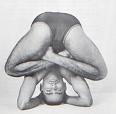|
| Oordhwaoordhwap
(Headstand, Lotus Pose) |
|
Translate:













|
| |
|
Variation 1 : After securing the balance
in the headstand, advanced students take up this exercise
to bring maximum flexibility to the ankle, knee and hip joints.
Before trying to do this exercise, one should be able to sit
in the lotus pose. The technique and benefits are the same
as for the headstand. However, here we go further and while
standing on the head, we lock the legs on padmasan or lotus
pose. Do not attempt to start the headstand while sitting
in padmasan.
There are three variations of this exercise to stretch the
lumbar and sacral vertebrae and their ligaments. The lumbar
and sacral parts of the vertebral column are twisted to both
sides and bent. This is to be repeated at least three times.
It will strengthen the ligaments and the vertebral column.
Variation 2 : Twisting of the spine in both
directions should be practiced by advanced students. Generally
we twist our bodies while sitting or standing. But in this
pose the lumbar region is naturally relaxed, and therefore
free rotation of the spine is possible. |
 
 
|
|
Variation 3 And 4 : To complete the movement
in oordhwapadmasan, the knees should be brought down, without
unlocking the lotus pose, and touch the armpit. When the arms
are kept separated the knees can be rested on the arms.
This exercise is similar to the headstand. In headstand, circulation
and concentration are directed to the brain, but in shoulderstand
the concentration and circulation are directed to the thyroid
and parathyroid. We have seen in previous chapters what effect
the thyroid and parathyroid secretions have on the body. The
thyroid is the most important gland of the endocrine system,
and this exercise gives it a rich supply of blood. Again it
stretches the deltoids, supraspinatus, and infraspinatus of
the shoulder muscles. The chin lock by the chin on the chest
exerts an extra pressure on the thyroid through which its
secretions are kept at par. This asana is a good substitute
for modern thyroid treatment. The ligaments of the cervical
region are especially stretched in this exercise |
|
There are many variations of the shoulderstand to increase
the circulation and stretch various ligaments and muscles.
Sarvanga means all parts, so the very name suggests that this
pose is concerned with all parts of the body. It will also
give a helping hand for persons with varicose veins.
Fifteen minutes is the maximum for this pose; starting time
for beginners is one minute. Breathe normally through the
nose. Some persons practice this for half and hour. |
 |
| |
|
| |
|
|